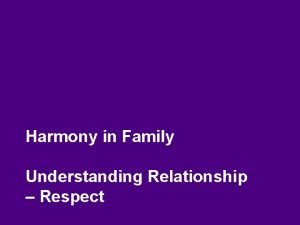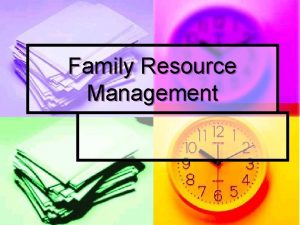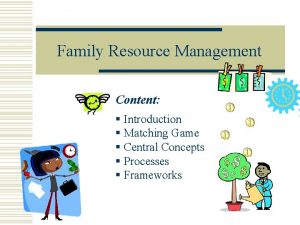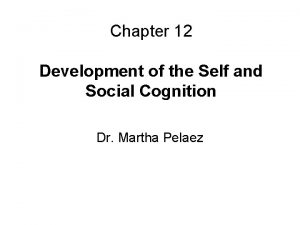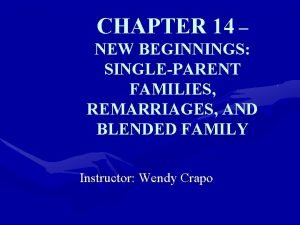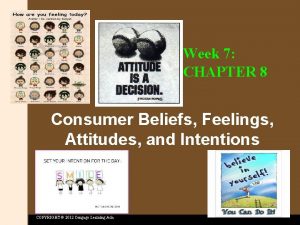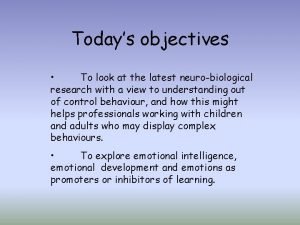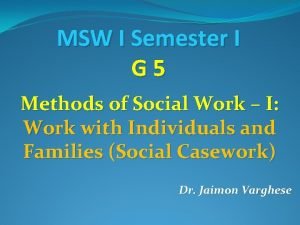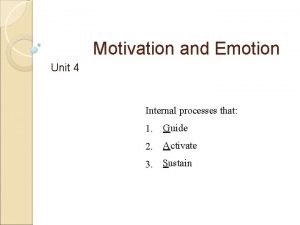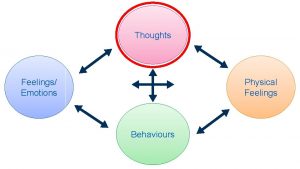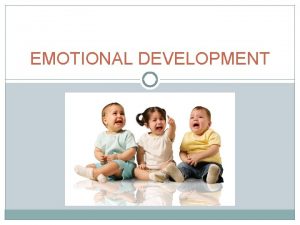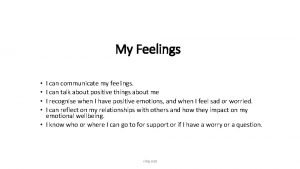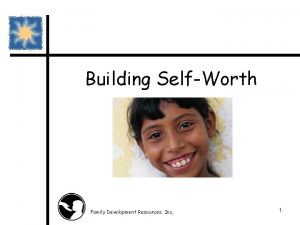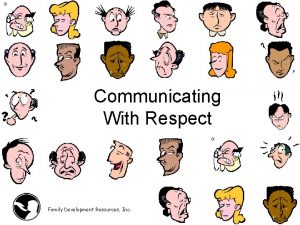Understanding Feelings Family Development Resources Inc 1 Feelings





























- Slides: 29

Understanding Feelings Family Development Resources, Inc. 1

Feelings • Most people have learned that there are two types of feelings: Good and Bad. 2

Feelings • There is no such thing as a bad feeling since all feelings are an expression of an experience. • When we categorize feelings as good or bad, we also categorize the people who have them as good or bad. 3

Feelings • Instead of referring to feelings as good or bad, we can group them into feelings of comfort, and feelings of discomfort. • That way it’s the feelings we are labeling, not the people who have the feeling. 4

Feelings of Comfort • Feelings of comfort include: – Love. – Peace. – Joy. – Contentment. – Happiness. – Satisfaction. – All other feelings that influence the person in a positive way. 5

Feelings of Discomfort • Feelings of discomfort are feelings create an unsettled feeling inside. For example: – Hate. – Envy. – Jealousy. – Anger. – Frustration. – Sadness. 6

Feelings of Discomfort • The goal is not to deny feelings of discomfort. • The goal is to manage the feelings so the feelings do not take over your life. 7

How To Manage Feelings • Awareness – The way your body responds to a feeling. – The name you give the feeling. – Awareness of the situation or similar situations that generate specific feelings. 8

How To Manage Feelings • Acceptance – The second step in managing feelings is a general acceptance that whatever you are feeling is OK, and that you are not a bad person for having such feelings. – Instead of accepting a feeling, many people deny, pretend or mask the feeling. 9

How To Manage Feelings • Communication – When it comes to expressing feelings, such communication can either be verbal or non-verbal. – All feelings have energy which gives the feelings life. 10

How To Manage Feelings • Three helpful rules in expressing energy are: – Respect yourself - don't hurt others. – Respect others - don't hurt others. – Respect the environment - don't destroy property, animals, or nature. 11

Hiding Your Feelings • When past experiences in our lives have been very painful, there is a tendency for many of us to avoid dealing with the pain. • Examples are the death of a loved one, the breakup of a meaningful relationship, a bad investment of money, or some painful experience in childhood. 12

Hiding Your Feelings • We will either try to forget the experience altogether, or we will attempt to get rid of the painful feelings by stuffing them inside. • Neither works very well in the long run. The painful feelings do not go away; they are just out of sight. 13

Hiding Your Feelings • We learn very early in life not to deal with pain or other feelings of discomfort. 14

Letting Go of Past Pain • An unpleasant experience we have had that we are unwilling or unable to deal with acts as a giant spring. • We have to squash by applying pressure to it. 15

Letting Go of Past Pain • The moment we let up on the spring, it becomes fully extended. • This is just like the painful feelings that come leaping into our mind. • When that happens, we relive the experience again. 16

Letting Go of Past Pain • The first step is to use healthy strategies to express your feelings of discomfort, and not hide them. • The effort involved in feeling free and being able to nurture yourself and others may not be easy, but it is certainly worth it. 17

Helping Children Handle Their Feelings • How we prepare our children to handle their feelings will affect the quality of their life more than any other element of parenting. • The worst thing we can do as parents is to not prepare children for the tasks and challenges of life. 18

Children and Their Feelings • Help children handle their feelings, and the world is theirs. • Let them struggle in their ways to recognize, express and handle their feelings, and difficulty will be theirs. 19

Children and Their Feelings • Children that learn to handle their feelings develop a sense of competence. • Children who think they are competent are easier children to parent and to be around. 20

Emotional Competence • Emotional competence is the ability for parents and children to be able to recognize and express their feelings in appropriate ways. 21

Ways to Build Emotional Competence • Let children know all feelings are OK. – Children have to believe that all feelings are good and useful in communicating. – It is HOW the feelings are communicated that can either be OK or not OK. 22

Ways to Build Emotional Competence • Label the feeling you see or think you see. – For example, “You look “happy. ” – This will give the child a feeling of being believed and respected. 23

Ways to Build Emotional Competence • Do not dominate the conversation. – Let the child do the talking. – Encourage sharing by looking interested in what your child is saying. 24

Ways to Build Emotional Competence • Promote rationale behind feelings. – Ask the question, “Why? ” For example: • “Why do you think he is feeling that way? ” • “Why are you feeling so sad? ” 25

Ways to Build Emotional Competence • Brainstorm with the child what, if anything, needs to be done. – Sometimes comforting a child is all that needs to be done, or simply just listening. 26

Ways to Build Emotional Competence • When a child wants something, honor their desire. – Children feel you understand appreciate their desires. – Once children realize that their feelings are honored, they are more open to listening to the logic why they cannot have what they want. 27

Ways to Build Emotional Competence • Teach children how to express their emotional energy. – All feelings have energy that need expression. – Brainstorm a list of physical things children can do to release their energy. 28

Ways to Build Emotional Competence • Praise, praise. – When children are expressing their feelings appropriately, let them know you like what you hear. – Remember, the behaviors you pay attention to are the behaviors that are being reinforced. – Catch your children behaving well. 29
 Feelings feelings feelings
Feelings feelings feelings Rehab resources inc
Rehab resources inc What is the transformation process
What is the transformation process Fixed resources
Fixed resources Renewable vs nonrenewable resources worksheet
Renewable vs nonrenewable resources worksheet Tree brother
Tree brother Respect is right evaluation
Respect is right evaluation Ece 355 understanding behavior & family dynamics
Ece 355 understanding behavior & family dynamics Family resources definition
Family resources definition Family resources
Family resources Development of self and social understanding
Development of self and social understanding Training plan for accounting department
Training plan for accounting department National aquatic resources research and development agency
National aquatic resources research and development agency Conclusion on topic family
Conclusion on topic family Periodic table families
Periodic table families Characteristics of single parent family
Characteristics of single parent family Define community development?
Define community development? Development that ended much development crossword
Development that ended much development crossword What are the two types of pattern development
What are the two types of pattern development Fishbein model
Fishbein model Labelling feelings
Labelling feelings Projection defense mechanism
Projection defense mechanism Spoken poetry english
Spoken poetry english What are the 7 principles of social work?
What are the 7 principles of social work? The patterns of feelings motives and behavior
The patterns of feelings motives and behavior Purposeful expression of feelings in social case work
Purposeful expression of feelings in social case work Incentive theory of motivation
Incentive theory of motivation Motivation is an internal process
Motivation is an internal process Macbeth act 3 scene 1 quotes
Macbeth act 3 scene 1 quotes I am poems
I am poems






